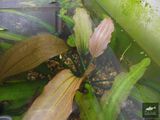Echinodorus After the fiery Barbus

| light: | |
|---|---|
| Temperature: | 22-28°C |
| Growth: | slow |
| Location: | medium - background |
| Height: | approx. 25 cm |
| pH: | 5-8 |
| Water hardness: | soft to hard |
| Co2: | 20-30mg/L |
| propagation: | Sprouts on
flowering shoot |
Origin / Breeder : Igor Filippov, Chelyabinsk
Description from the author's words: Quite compact Echinodorus. Leaves are on average 15 cm long and 5-6 wide. Petioles up to 10 cm The leaves of the young plants are narrow (in the picture). I keep three colored leaves. When it foolishly comes out of the water from a depth of 20 cm, it inevitably returns. This subject does not belong to him. Gives and flower shoots. which are not rich in daughter plants. and root points of growth. What is so interesting about this Echinodorus? 1.very dense leaf. It feels exactly dense and flexible. not hard. Slightly wavy. can fold the edges in the shape of an English letter U 2.Shiny longitudinal veins on young leaves. 3. most interesting: the leaves change color. Under stable conditions. those. At the rate of 24-26 grams, the leaf comes out with a very pleasant fresh pink color. Then it starts to lighten almost white. then the shiny veins on it turn green. and then the whole leaf turns green. But at a rate of 29-30 hours, the new leaves become pastel yellow ( For example, today three new leaves are pink. Coming the day after tomorrow. Rate 30. they are yellow ... After another two days, the rate dropped. the same three leaves are pink again. Why "the name of the fire barb?" First. No one has named this barbus. In any case. I don't know anything about it. Secondly. At the same time, pink and yellow leaves can be on the bush. and their colors are about the same as the color of male and female fire barbs in the aquarium of an unfortunate amateur. It is not necessary to compare this Echinodorus with Echinodorus Oriental ... they are different[1].
-
Echinodorus After the fiery Barbus[1]
-
Echinodorus After the fiery Barbus[1]
-
Echinodorus After the fiery Barbus[1]
- ↑ 1.0 1.1 1.2 1.3 Kostiantyn Loboda, Black Water http://echinodorus.com.ua/



